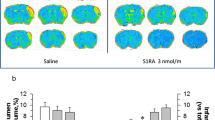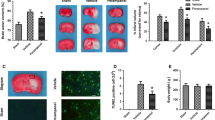Abstract
Sigma 1 receptors are intracellular chaperone proteins that have been explored as a subacute treatment to enhance post-stroke recovery. We recently identified the antitussive oxeladin as a selective sigma 1 receptor agonist with the ability to stimulate the release of brain-derived neurotrophic factor from neurons in vitro. In this study, we hypothesized that oral oxeladin citrate would stimulate BDNF secretion and improve stroke outcomes when administered to male rats starting 48 h after transient middle cerebral artery occlusion. Oxeladin did not alter blood clotting and crossed the blood brain barrier within 30 min of oral administration. Rats underwent 90 min of transient middle cerebral artery occlusion. Forty-eight hours later rats began receiving daily oxeladin (135 mg/kg) for 11 days. Oxeladin significantly improved neurological function on days 3, 7, and 14 following MCAO. Infarct size was not altered by a single dose, but the final extent of infarct after 14 days was decreased. However, there was no significant reduction in astrogliosis or microgliosis compared to vehicle-treated control rats. In agreement with in vitro studies, oxeladin increased the amount of mature BDNF in the cerebral cortex 2, 6, and 24 h after single oral dose. However, the increase in BDNF did not result in increases in cellular proliferation in the subventricular zone or dentate gyrus when compared to vehicle-treated controls. These results suggest that oxeladin may reduce the extent of infarct expansion in the subacute phase of stroke, although this action does not appear to involve a reduction in inflammation or increased cell proliferation.










Similar content being viewed by others
Data Availability
The corresponding author will make data available upon request.
References
Goenka L, Uppugunduri CR, Satyanarayana SKS, George M. Neuroprotective agents in Acute Ischemic Stroke-A Reality Check. Biomed Pharmacother. 2019;109:2539–47.
Narayan SK, et al. Preclinical animal studies in ischemic stroke: Challenges and some solutions. Animal Model Exp Med. 2021;4(2):104–15.
Chen C, et al. Clinical effects and safety of edaravone in treatment of acute ischaemic stroke: A meta-analysis of randomized controlled trials. J Clin Pharm Ther. 2021;46(4):907–17.
Chollet F, et al. Fluoxetine for motor recovery after acute ischaemic stroke (FLAME): a randomised placebo-controlled trial. Lancet Neurol. 2011;10(2):123–30.
Malhotra K, et al. Minocycline for acute stroke treatment: a systematic review and meta-analysis of randomized clinical trials. J Neurol. 2018;265(8):1871–9.
Lundstrom E, et al. Effects of Fluoxetine on Outcomes at 12 Months After Acute Stroke: Results From EFFECTS, a Randomized Controlled Trial. Stroke. 2021;52(10):3082–7.
Strickland BA, et al. Neuroprotective effect of minocycline against acute brain injury in clinical practice: A systematic review. J Clin Neurosci. 2021;86:50–7.
Ghosh D et al. Drug repurposing for stroke intervention. Drug Discov Today. 2022.
Lyden PD. Cerebroprotection for Acute Ischemic Stroke: Looking Ahead. Stroke. 2021;52(9):3033–44.
Desai SM, Jha RM, Linfante I. Collateral Circulation Augmentation and Neuroprotection as Adjuvant to Mechanical Thrombectomy in Acute Ischemic Stroke. Neurology. 2021;97(20 Suppl 2):S178–84.
Schmidt HR, Kruse AC. The Molecular Function of sigma Receptors: Past, Present, and Future. Trends Pharmacol Sci. 2019;40(9):636–54.
Ryskamp DA, et al. Neuronal Sigma-1 Receptors: Signaling Functions and Protective Roles in Neurodegenerative Diseases. Front Neurosci. 2019;13:862.
Penke B, Fulop L, Szucs M, Frecska E. The Role of Sigma-1 Receptor, an Intracellular Chaperone in Neurodegenerative Diseases. Curr Neuropharmacol. 2018;16(1):97–116.
Bogar F, Fulop L, Penke B. Novel Therapeutic Target for Prevention of Neurodegenerative Diseases: Modulation of Neuroinflammation with Sig-1R Ligands. Biomolecules. 2022;12(3):363.
Maurice T, Lockhart BP. Neuroprotective and anti-amnesic potentials of sigma (sigma) receptor ligands. Prog Neuropsychopharmacol Biol Psychiatry. 1997;21(1):69–102.
Li Z, et al. DHEA-neuroprotection and -neurotoxicity after transient cerebral ischemia in rats. J Cereb Blood Flow Metab. 2009;29(2):287–96.
Ruscher K, et al. The sigma-1 receptor enhances brain plasticity and functional recovery after experimental stroke. Brain : a journal of neurology. 2011;134(Pt 3):732–46.
Katnik C, et al. Treatment with afobazole at delayed time points following ischemic stroke improves long-term functional and histological outcomes. Neurobiol Dis. 2014;62:354–64.
Urfer R, et al. Phase II trial of the Sigma-1 receptor agonist cutamesine (SA4503) for recovery enhancement after acute ischemic stroke. Stroke. 2014;45(11):3304–10.
Nguyen L, et al. Sigma-1 Receptors and Neurodegenerative Diseases: Towards a Hypothesis of Sigma-1 Receptors as Amplifiers of Neurodegeneration and Neuroprotection. Adv Exp Med Biol. 2017;964:133–52.
An Y, et al. Activation of the sigma-1 receptor attenuates blood-brain barrier disruption by inhibiting amyloid deposition in Alzheimer’s disease mice. Neurosci Lett. 2022;774:136528.
Li W, et al. Protective Mechanism and Treatment of Neurogenesis in Cerebral Ischemia. Neurochem Res. 2020;45(10):2258–77.
Sims SK, et al. Brain-Derived Neurotrophic Factor and Nerve Growth Factor Therapeutics for Brain Injury: The Current Translational Challenges in Preclinical and Clinical Research. Neural Plast. 2022;2022:3889300.
He J, et al. Molecular mechanism of estrogen-mediated neuroprotection in the relief of brain ischemic injury. BMC Genet. 2018;19(1):46.
Schreihofer DA, Oppong-Gyebi A. Genistein: mechanisms of action for a pleiotropic neuroprotective agent in stroke. Nutr Neurosci. 2019;22(6):375–91.
Shi N, Zhu C, Li L. Rehabilitation Training and Resveratrol Improve the Recovery of Neurological and Motor Function in Rats after Cerebral Ischemic Injury through the Sirt1 Signaling Pathway. Biomed Res Int. 2016;2016:1732163.
Liu K, et al. Acute Administration of Metformin Protects Against Neuronal Apoptosis Induced by Cerebral Ischemia-Reperfusion Injury via Regulation of the AMPK/CREB/BDNF Pathway. Front Pharmacol. 2022;13:832611.
Dalwadi DA, et al. Brain-derived neurotrophic factor for high-throughput evaluation of selective Sigma-1 receptor ligands. J Pharmacol Toxicol Methods. 2022;113:107129.
Kim S, et al. Vivo-Morpholino knockdown of alphaIIb: A novel approach to inhibit thrombocyte function in adult zebrafish. Blood Cells Mol Dis. 2010;44(3):169–74.
Dalwadi DA, Kim S, Schetz JA. Activation of the sigma-1 receptor by haloperidol metabolites facilitates brain-derived neurotrophic factor secretion from human astroglia. Neurochem Int. 2017;105:21–31.
Oppong-Gyebi A, et al. Long-term hypogonadism diminishes the neuroprotective effects of dietary genistein in young adult ovariectomized rats after transient focal ischemia. J Neurosci Res. 2022;100(2):598–619.
Borlongan CV, Sanberg PR. Elevated body swing test: a new behavioral parameter for rats with 6-hydroxydopamine-induced hemiparkinsonism. J Neurosci. 1995;15(7 Pt 2):5372–8.
Bederson JB, et al. Rat middle cerebral artery occlusion: evaluation of the model and development of a neurologic examination. Stroke. 1986;17(3):472–6.
Swanson RA, et al. A semiautomated method for measuring brain infarct volume. J Cereb Blood Flow Metab. 1990;10(2):290–3.
Sauerzweig S, Baldauf K, Braun H, Reymann KG. Time-dependent segmentation of BrdU-signal leads to late detection problems in studies using BrdU as cell label or proliferation marker. J Neurosci Methods. 2009;177(1):149–59.
Ajmo CT Jr, et al. Sigma receptor activation reduces infarct size at 24 hours after permanent middle cerebral artery occlusion in rats. Curr Neurovasc Res. 2006;3(2):89–98.
Ruscher K, et al. Effects of the sigma-1 receptor agonist 1-(3,4-dimethoxyphenethyl)-4-(3-phenylpropyl)-piperazine dihydro-chloride on inflammation after stroke. PLoS ONE. 2012;7(9):e45118.
Schetz JA, et al. A prototypical Sigma-1 receptor antagonist protects against brain ischemia. Brain Res. 2007;1181:1–9.
Sato S, Kawamata T, Kobayashi T, Okada Y. Antidepressant fluvoxamine reduces cerebral infarct volume and ameliorates sensorimotor dysfunction in experimental stroke. NeuroReport. 2014;25(10):731–6.
Zhao Q, et al. The Protective Effects of Dexmedetomidine against Hypoxia/Reoxygenation-Induced Inflammatory Injury and Permeability in Brain Endothelial Cells Mediated by Sigma-1 Receptor. ACS Chem Neurosci. 2021;12(11):1940–7.
Shen YC, et al. Dimemorfan protects rats against ischemic stroke through activation of sigma-1 receptor-mediated mechanisms by decreasing glutamate accumulation. J Neurochem. 2008;104(2):558–72.
Werling LL, Lauterbach EC, Calef U. Dextromethorphan as a potential neuroprotective agent with unique mechanisms of action. Neurologist. 2007;13(5):272–93.
Chou YC, et al. Binding of dimemorfan to sigma-1 receptor and its anticonvulsant and locomotor effects in mice, compared with dextromethorphan and dextrorphan. Brain Res. 1999;821(2):516–9.
Sanchez-Blazquez P, Pozo-Rodrigalvarez A, Merlos M, Garzon J. The Sigma-1 Receptor Antagonist, S1RA, Reduces Stroke Damage, Ameliorates Post-Stroke Neurological Deficits and Suppresses the Overexpression of MMP-9. Mol Neurobiol. 2018;55(6):4940–51.
Wu NH, et al. Emerging Benefits: Pathophysiological Functions and Target Drugs of the Sigma-1 Receptor in Neurodegenerative Diseases. Mol Neurobiol. 2021;58(11):5649–66.
Kikuchi-Utsumi K, Nakaki T. Chronic treatment with a selective ligand for the sigma-1 receptor chaperone, SA4503, up-regulates BDNF protein levels in the rat hippocampus. Neurosci Lett. 2008;440(1):19–22.
Fujimoto M, et al. Sigma-1 receptor chaperones regulate the secretion of brain-derived neurotrophic factor. Synapse. 2012;66(7):630–9.
Liu W, et al. Brain-Derived Neurotrophic Factor and Its Potential Therapeutic Role in Stroke Comorbidities. Neural Plast. 2020;2020:1969482.
Ravina K, et al. Intracerebral Delivery of Brain-Derived Neurotrophic Factor Using HyStem((R))-C Hydrogel Implants Improves Functional Recovery and Reduces Neuroinflammation in a Rat Model of Ischemic Stroke. Int J Mol Sci. 2018;19(12):3782.
Ploughman M, et al. Brain-derived neurotrophic factor contributes to recovery of skilled reaching after focal ischemia in rats. Stroke. 2009;40(4):1490–5.
Zhao X, et al. Sigma-1 receptor protects against endoplasmic reticulum stress-mediated apoptosis in mice with cerebral ischemia/reperfusion injury. Apoptosis. 2019;24(1–2):157–67.
Morihara R, et al. Protective effect of a novel sigma-1 receptor agonist is associated with reduced endoplasmic reticulum stress in stroke male mice. J Neurosci Res. 2018;96(10):1707–16.
Kanno H, et al. Chaperone-Mediated Autophagy in Neurodegenerative Diseases and Acute Neurological Insults in the Central Nervous System. Cells. 2022;11(7):1205.
Zhang Y, et al. Activation of Sigma-1 Receptor Enhanced Pericyte Survival via the Interplay Between Apoptosis and Autophagy: Implications for Blood-Brain Barrier Integrity in Stroke. Transl Stroke Res. 2020;11(2):267–87.
Ozawa H, Fukuda H, Otsuki I, Chiba S. Antitussive activity and acute toxicity of 2-(2-diethylamino-ethoxy)ethyl alpha, alpha-diethylphenylacetate (oxeladin). Yakugaku Zasshi. 1962;82:1314–7.
Talbot J, Waller P. Sephens’ Detection of New Adverse Drug Reactions. 6 ed. 2004: John Wiley and Sons, Ltd.
Nguyen L, et al. Dextromethorphan: An update on its utility for neurological and neuropsychiatric disorders. Pharmacol Ther. 2016;159:1–22.
Lee SJ, Yeom SY, Lee JY, Park C. Application of the antitussive agents oxelaidin and butamirate as anti-glioma agents. Sci Rep. 2021;11(1):10145.
Acknowledgements
The authors thank Dr. Fen Sun for help in performance of these experiments.
Funding
This work was supported by the National Institutes of Health NIH 1R21NS095271-01A1 to D.A.S. and J.A.S.
Author information
Authors and Affiliations
Contributions
Derek A. Schreihofer: Conceptualization; Data curation; Formal analysis; Funding acquisition; Investigation; Methodology; Project administration; Resources; Supervision; Validation; Visualization; Writing—original draft; Writing—review & editing. Dhwanil Dilwadi: Investigation. Seongcheol Kim: Investigation, Formal analysis. Daniel Metzger: Investigation, Formal analysis. Anthony Oppong-Gyebi: Investigation, Formal analysis. Paromita Das-Earl: Investigation, Methodology. John A. Schetz: Conceptualization; Data curation; Formal analysis; Funding acquisition; Methodology; Project administration; Resources; Supervision; Validation.
Corresponding author
Ethics declarations
Ethical Approval
All procedures were approved by the UNTHSC Institutional Animal Care and Use Committee in accordance with the Guide for the Care and Use of Laboratory Animals.
Competing Interests
Derek A. Schreihofer wishes to declare on behalf of himself and John A. Schetz (deceased).
U.S. Provisional Patent Application.
Title: Drug Repurposing For Delayed Treatment of Ischemic Stroke.
Serial NO.: 63/308,259.
Filing data: February 9, 2022.
Inventors: D. Schreihofer and J. Schetz.
HSC Ref. No.: 2021–016-01.PRO.
Attorney File No.: UNTH.P0008US.P1.
Additional information
Publisher's Note
Springer Nature remains neutral with regard to jurisdictional claims in published maps and institutional affiliations.
John A. Schetz is deceased. This paper is dedicated to his memory.
Rights and permissions
Springer Nature or its licensor (e.g. a society or other partner) holds exclusive rights to this article under a publishing agreement with the author(s) or other rightsholder(s); author self-archiving of the accepted manuscript version of this article is solely governed by the terms of such publishing agreement and applicable law.
About this article
Cite this article
Schreihofer, D.A., Dalwadi, D., Kim, S. et al. Treatment of Stroke at a Delayed Timepoint with a Repurposed Drug Targeting Sigma 1 Receptors. Transl. Stroke Res. (2023). https://doi.org/10.1007/s12975-023-01193-x
Received:
Revised:
Accepted:
Published:
DOI: https://doi.org/10.1007/s12975-023-01193-x




